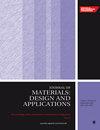Mechanical, corrosion and tribological behavior of friction stir processed AZ31B/egg shell /WS2 hybrid surface composite
IF 2.2
4区 材料科学
Q3 MATERIALS SCIENCE, MULTIDISCIPLINARY
Proceedings of the Institution of Mechanical Engineers, Part L: Journal of Materials: Design and Applications
Pub Date : 2024-08-27
DOI:10.1177/14644207241277945
引用次数: 0
Abstract
In the present work, egg shell and Tungsten disulphide particles are reinforced in AZ31B alloy using friction stir process. Initially, the ES and WS摩擦搅拌加工的 AZ31B/蛋壳/WS2 混合表面复合材料的力学、腐蚀和摩擦学行为
在本研究中,使用搅拌摩擦工艺在 AZ31B 合金中强化了蛋壳和二硫化钨颗粒。首先,以不同的重量比(25/75、50/50 和 75/25)混合蛋壳和二硫化钨颗粒,然后使用锥形螺纹 FSP 工具,以 1000 rpm 的转速、6 kN 的轴向载荷和 10 mm/min 的横移速度在孔法中对 AZ31B 板进行增强。后宏观分析表明,在 AZ31B 合金中添加 75wt %ES 和 25wt % WS2 颗粒后,获得了无缺陷混合表面复合材料。由于通过 FSP 添加了 75wt % ES 和 25wt % WS2 颗粒,晶粒尺寸从 15 µm 减小到 5 µm。观察了 AZ31B/75ES/25WS2 混合表面复合材料的机械、腐蚀和摩擦学反应,并将其与不添加增强剂的 AZ31B 合金和 AZ31B 基础合金进行了比较。与 AZ31B 基合金相比,FSPed AZ31B 合金和 AZ31B/75ES/25WS2 混合表面复合材料的显微硬度分别提高了 66% 和 83%。同样,与 AZ31B 基合金相比,FSPed AZ31B 合金和 AZ31B/75ES/25WS2 混合表面复合材料的极限抗拉强度分别提高了 16% 和 31%,但与 AZ31B 基合金相比,FSPed AZ31B 合金和 AZ31B/75ES/25WS2 混合表面复合材料的伸长率分别降低了 70% 和 78%。与 AZ31B 基合金相比,FSPed AZ31B 合金和 AZ31B/75ES/25WS2 混合表面复合材料的腐蚀率分别降低了 22% 和 48%。通过改变施加载荷(10 N、20 N 和 30 N)和滑动速度(1.5 m/s、2.6 m/s 和 3.6 m/s),并保持 2000 m 的滑动距离,观察了 AZ31B 基合金和 AZ31B/75ES/25WS2 混合表面复合材料的干滑动摩擦和磨损响应。在 AZ31B/75ES/25WS2 混合表面复合材料中,磨损机理主要是粘合和分层现象,在高滑动条件下,形成的摩擦层降低了磨损率。
本文章由计算机程序翻译,如有差异,请以英文原文为准。
求助全文
约1分钟内获得全文
求助全文
来源期刊

CiteScore
4.70
自引率
8.30%
发文量
166
审稿时长
3 months
期刊介绍:
The Journal of Materials: Design and Applications covers the usage and design of materials for application in an engineering context. The materials covered include metals, ceramics, and composites, as well as engineering polymers.
"The Journal of Materials Design and Applications is dedicated to publishing papers of the highest quality, in a timely fashion, covering a variety of important areas in materials technology. The Journal''s publishers have a wealth of publishing expertise and ensure that authors are given exemplary service. Every attention is given to publishing the papers as quickly as possible. The Journal has an excellent international reputation, with a corresponding international Editorial Board from a large number of different materials areas and disciplines advising the Editor." Professor Bill Banks - University of Strathclyde, UK
This journal is a member of the Committee on Publication Ethics (COPE).
 求助内容:
求助内容: 应助结果提醒方式:
应助结果提醒方式:


